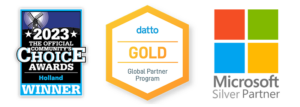It can take several days, even months, to identify a data compromise, and it’s easy to see why. Modern security tools can generate millions of security alerts over the course of a day. A SIEM solution filters out the noise, so the real threats get immediate attention. In this post, we explore some frequently asked questions (FAQs) relating to Security Information and Event Management (SIEM).
- What Does SIEM Stand for?
- What Is a SIEM?
- Why Is a SIEM Important?
- How Does SIEM Work?
- Who Needs a SIEM?
What Does SIEM Stand for?
SIEM stands for Security Information and Event Management.
What Is a SIEM?
A SIEM is a 24/7/365 intelligent threat detection system. It collects logs and analyzes threat alerts across your network, so critical alerts get immediate remediation before they can cause serious harm to your business.
Why Is a SIEM Important?
- Compliance: Compliance regulations require documentation and reporting. A SIEM solution provides centralized, built-in, easy-to-use, real-time log collection, alerting and reporting features.
- Visibility: A SIEM solution provides real-time visibility into what’s happening across your entire network — 24/7/365.
- Remediation: Real threats are identified, isolated and remediated quickly before they can cause serious harm and costly business disruptions.
How Does SIEM Work?
SIEM works via Events, Rules, Incidents, and Notifications (E-R-I-N).
- Events. First, we collect millions of security alerts, or events, from your entire network.
- Rules. Then, we apply rules to determine which events are actionable threats. (These threats become incidents.)
- Incidents. Next, the most critical incidents get immediate attention.
- Notifications. Finally, your response team is instantly notified so remediation can begin.
Who Needs a SIEM?
With today’s ever-evolving cybersecurity landscape, a SIEM solution plays a critical role in staying ahead of the latest threats. And while every business can benefit from a SIEM, those that must comply with industry and government regulations and those looking to qualify for cybersecurity insurance will find it essential.
As a Holland, Michigan Managed Service Provider (MSP), we offer more than just server disaster recovery and break-fix IT support. We evaluate and organize your network, keeping your data backed up and secure—at all times. Don’t wait for server disaster to find a qualified Managed Services Provider. Reach out to Shoreline Technology Solutions today. Our information technology company will evaluate your network free-of-charge and provide you with best-in-class hardware and cloud-based solutions.

President / Network Architect
Mark Kolean always had a fascination with technology from the time he was 3 and his gift of the Atari 2600 to current. In 1990 at the age of 14 Mark got his first job in customer support for a mail order business supporting Tandy TSR-80 computer software shipped on cassette tape. A few years later Mark was building hundreds of 286, 386, and 486 computers for the new emerging DOS & Windows 3.1 computers that had exploded on the market.
After a college career studying business and technology Mark Started Shoreline Computer Systems in 1999 at the height of the dot.com boom with the looming crisis of the year2k bug just around the corner. In the early 2000’s a lot of work was done with early network systems including Lantastic, Novell, and Windows NT Server. Mark became a community contributor to the Small Business Specialist community that revolved around Small Business Server 2000-2011 which focused on single or dual server environments for businesses up to 50 in size. Networks during this time frame mostly had a break fix relationship in which work was billed only when a problem occurred.
In the 2010’s Microsoft released their first cloud based software called Microsoft BPOS which would in later become known as Microsoft Office 365. This introduced a new model in technology with pay as you go subscription services. Starting in 2013 Mark’s team at Shoreline Computer System rebranded as Shoreline Technology Solutions to focus on the transition to become proactive and less reactive to data backup and security needs. Starting in 2018 all customers are required to have a backup management plan in place as a center point with the full understanding that if STS isn’t watching the customer’s data, then no one is.
Now in Mark’s 22 years of business he is building a company emphasis of how to help customers retire servers and build networks completely in the cloud.


Leave a Reply
You must be logged in to post a comment.